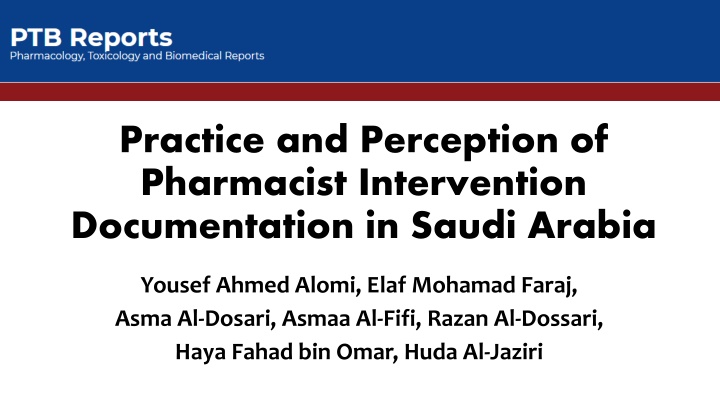
Exploring Pharmacist Intervention Documentation in Saudi Arabia
This study delves into the practice and perception of pharmacist intervention documentation in Saudi Arabia. It examines pharmacist intervention elements, clinical impact documentation, perceptions, and barriers. Results show room for improvement in documentation practices to enhance the clinical and economic benefits of pharmacists in the region.
Download Presentation

Please find below an Image/Link to download the presentation.
The content on the website is provided AS IS for your information and personal use only. It may not be sold, licensed, or shared on other websites without obtaining consent from the author. If you encounter any issues during the download, it is possible that the publisher has removed the file from their server.
You are allowed to download the files provided on this website for personal or commercial use, subject to the condition that they are used lawfully. All files are the property of their respective owners.
The content on the website is provided AS IS for your information and personal use only. It may not be sold, licensed, or shared on other websites without obtaining consent from the author.
E N D
Presentation Transcript
Practice and Perception of Pharmacist Intervention Documentation in Saudi Arabia Yousef Ahmed Alomi, Elaf Mohamad Faraj, Asma Al-Dosari, Asmaa Al-Fifi, Razan Al-Dossari, Haya Fahad bin Omar, Huda Al-Jaziri
Objectives: To explore the practice and perceptions of pharmacist intervention documentation in the Kingdom of Saudi Arabia. Methods: This is a 4-month cross-sectional self-administered survey of documentation of pharmacist intervention. The study consisted of two parts: the first part collected demographic information and the second part comprised of a questionnaire with a total of 18 ques tions. There were domains: pharmacist intervention documentation elements, documentation of clini cal impact and cost avoidance, the perception of pharmacist intervention and the barrier of pharmacist intervention documentation. All kinds of pharmacist professionals were included in the survey. We used 5-point Likert response scale system to obtain responses. There were open and close-ended questions. The survey was distributed in an electronic format through the social media (WhatsApp and others) to more than 1000 pharmacist professionals across the Kingdom of Saudi Arabia. The data were obtained through the Survey Monkey system.
Results: A total of 128 pharmacists responded to the questionnaire. Of them, 106 (82.81%) were Saudi and 22 (17.19%) were non-Saudi pharmacists. Majority of the responders were in the age group of 25 34 years and 35 44 years (44.53% and 25.00%, respectively). Most of the responders had obtained their Bachelor of Science in Pharmacy degree (40 (31.25%)) and Diploma in Pharmacy (33 (25.78%)) with the majority of pharmacists (112 (87.50%)) not having accreditation for the Board of Pharmaceutical Specialty. Most of the pharmacist-reported intervention items was for brief description of the intervention (94.49 %), date of intervention (93.75%) and pharmacist s name/identification (93.70%), whereas least reported items was the effect of cost-saving (45.57%), time spent on providing intervention (51.61%) and drug therapeutic classification (65.73%). Most of the documentation of clinical impact and cost avoidance were related to the general pharmacist intervention (75.78%), adverse drug reaction (72.66%) and drug quality reporting (72.22%). Most of the barriers that prevent documentation of pharmacist intervention was lack of time (98 (76.56%)) followed by the statement there is no system for pharmacist intervention (43 (33.59%)) and the analysis of pharmacist intervention does not exist (41 (32.03%)). Conclusion: Half of the responder s showed compliance with the practice of pharmacist intervention documentation in the Kingdom of Saudi Arabia. The clinical impact and cost avoidance impact of the pharmacist does not adhere to the documentation with half of the responders. The electronic documentations of pharmacist intervention presented with half of the responders. We recommend to remove the barriers and encourage the pharmacist to carry out documentation. This will improve the system and will improve the clinical and economic benefit of the pharmacist in the Kingdom of Saudi Arabia.
KEYWORDS Practice, Perception Pharmacist, Intervention, Documentation, Saudi Arabia.
